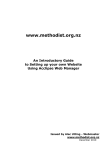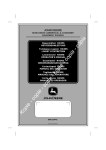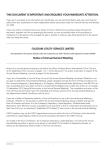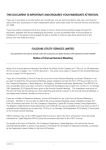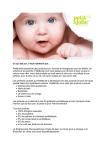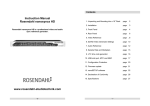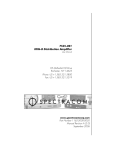Download Inserting Links
Transcript
www.methodist.org.nz An Introductory Guide to Setting up your own Parish Website Using WebXOffice Issued by Alec Utting - Webmaster www.methodist.org.nz May 2008 www.methodist.org.nz An Introductory Guide to Setting up your own Parish Website Using WebXOffice Contents Equipment and Software Check Logging in Turning off the Pop-Up Blocker The Front-end Menu System The Back-end Directory Structure Using the Site Tree Inserting new Categories, Containers and Pages Editing Your Web page Main Content Editor Toolbar Text Editing Toolbar Inserting Images and Pictures Resizing the image with the Office Picture Manager Resize Picture Compress Picture Uploading Images and Pictures Inserting Links Insert Link to another Page Insert Link to another Web site Insert Link to a file Insert link to an email Insert Link to Text within a Page (Target Link) Insert Link to a Image Gallery Inserting tables Creating and Using Enquiry Forms Naming the Data Boxes Thank You Response Response Templates Setup Response Addresses Enquiry Responses 3 3 3 4 4 5 7 8 8 9 10 11 12 12 13 14 14 15 15 15 16 16 17 18 19 20 20 21 22 The Image Gallery 22 Adding images to the Group Adding Descriptions to Images Linking the Image Gallery into a Page Connecting to your web page from another website Getting a user name and password Changing your password Creating Short Addresses Contacting the Webmaster Inserting your own picture at the top of your page 22 23 23 24 24 24 24 24 24 Disclaimer: This Guide is only an introduction and is not intended to be a full User Manual. Descriptions of many functions are omitted. It is to help users of Methodist.org.nz get started in creating their own Web pages. The On-line help should be used for a fuller description of the various functions provided. 2 Equipment and Software Check Before opening WebXOffice, please make the following equipment and software checks: You are using a PC with Windows XP or earlier. Windows Vista and Macintosh computers are not currently supported. You have Internet Explorer 5.5 (or later) web browser on your computer. Netscape, Opera and other web browsers are not supported. You are connected to the internet. Your Internet Explorer browser is not blocking pop-ups from your website. Please refer to Turning off the Pop-Up Blocker below for more information. That you have Java loaded. (To download Java, Enter “Java Download” in Google and follow instructions.) That you have a username and Password. (If you do not have these, contact the Webmaster who may be contacted by going to www.methodist.org.nz and selecting Resources.) Logging in 1. Enter www.methodist.org.nz/admin in the Address field in Internet Explorer. 2. Enter your username and password. Turning off the Pop-Up Blocker The login to the back-end of your website is a pop-up window. If your browser has been set to block pop-ups you will not be able to log in. You can either turn off your pop-up blocker or allow pop-ups on this website. 1. Select Tools in the menu at the top of your Internet Explorer browser. 2. Select Internet Options from the drop down list. 3. Select the Privacy tab. 4. To turn off the pop-up blocker across all websites you view, un-tick the Block pop-ups checkbox. 5. To leave the pop-up blocker on but allow pop-ups for your website: a. Leave the Block pop-ups checkbox ticked. b. Select the Settings button to the right o of the checkbox. c. Enter http://www.methodist.org.nzin in the field at the top and select Add. d. Select Close at the bottom right. 6. Select Apply at the bottom right and then OK. 3 The Front-end Menu System This can be seen when you go to www.methodist.org.nz Lo Clicking on any of the menu items takes you to a page. e.g. Clicking on each of Find us, Central South Island, Parish Information or Beckenham, will take you to four different pages. The Back-end Directory Structure This can be seen when you go to www.methodist.org.nz/admin The structure of the menu system is created in the Back-end, the order being determined by the order of the items in the box on the right. The Site Tree is shown on the left. 4 Using the Site Tree The Site Tree shown on the previous page, can be opened up by clicking on the + sign to the left of the folder icon (Category). To close up the tree, click on the - signs. In the example shown I have in turn, opened up the Find Us Central South Island Parish Information Beckenham and Data categories. Within each of these there may be Categories - e.g. Find Us Pages - e.g. Index Containers - e.g. data Enquiry Forms - e.g. Contact Us form Files The icons represent Adobe (.pdf) files, Word files and Excel files. Other types of files such as picture files may also be included. Links to other web pages and sites. The example below shows some examples of Adobe files (Easter Camp 2008) and a picture file (P2) - the picture icon shown in the Site tree may differ depending upon the default program set on your computer to display pictures. Each category Each new category may contains a variety of each of the above. or file within a category creates a new menu item on the Front-end display. 5 Example: Back-end Front-end The categories with the red (shaded) background are marked as hidden and are not displayed. When you click on a menu item on the Front-end display, the first page in the category is not displayed as a menu item on the Front-end but all following pages and files within that category are displayed. shows in the Front End as The arrow at the end of menu item indicates that there are further items in the menu. The first page in a category is displayed when that category is clicked on the Front-end. This page is usually called Index, and is a standard HTML page. When a category is created, the Index is created when the category is saved twice. This page is where you enter your Parish or Church web page and in most cases has already been created for you. Changing it is similar to changing a WORD document. 6 Inserting new Categories, Containers and Pages. Categories Containers Pages To insert a Category, Container or Page 1. Open the site tree so that you can see the Category or Container that you wish to put the new item in. 2. Double click on the name to open up the Category or Container. (In the example above I have double clicked on Beckenham to display the Category Settings on the RHS.) 3. Click on Insert on the top drop down menu. (Shown in the example above.) 4. Click on the item which you wish to insert. (Category, Container or Page.) 5. Give the Page a name. (Social in this example.) 6. Put in the Page Title a list of search words to help users find this page when using a web browser such as Google or Yahoo. 7. Check Full Window if you want this page to open in a new window. 8. Check Hidden if you only want to access this with a link from within another Page. 9. Important: Save this before continuing. 10. Click on Page to open up the page for editing. Inserting Categories and Containers are similar to inserting pages. If you want to alter the order of the items with a Category or Container, - Click on the Category or Container Name to open up the Category Settings. - Use the Top, Up, Down and Bottom buttons to change the item order. (See the Category box on the right of the graphic at the top of this page.) 7 Editing Your Web page Main Content Editor Toolbar Save Content Only - This saves only content on the page. This is quick as it does not redraw the screen. Cut the selected area. Copy the selected area. Paste the copied area into the page. Note: The right button menu does not function here. Undo the last editing action. Redo the last action. Align left, align centre, align right. Show the border on tables. Show the HTML source code. This can be edited but the heading and some other functions are cut out by WebXOffice. Insert a table. Insert an image. Inset a link. First select the picture or text that the link applies to. Insert a Target. Spell check. Paste from Word. Clean up Word document. And the dropdown text box allows you to quickly select Styles. Select the text first. 8 The menu tags above deal with the whole page setup. Some of their functions are Main Allows you to hide the page from viewing on the Front-end except through a link. Page Shows the edit page. Search Allows you to put in search words and a description for use in search engines. Also use the Page Title to put in Search words. Permissions Controls who can view and who can edit particular sections of your website. Navigations Allows you to change the menu structure. (This may not be visible.) Schedule Allows you to only have your page live at certain times. Text Editing Toolbar You can format the font of your text by: Either applying one of the styles, Or adjusting the font type, size, colour, and formatting using the Text Editing toolbar. Note that the font size is NOT a pixel size as in Word, but a size 1 to 7, where 1 is a small size. Set text colour. Set text to Bold, Italics and Underline. Indent paragraph, unindent paragraph. Bullets. Numbered points. Insert line across page. These all work much the same as in Word. If you want to use a font not shown, copy the text from Word or Wordpad. Note that the font only shows correctly if that font is also installed on the viewer’s computer so avoid using special and uncommon fonts. 9 Inserting Images and Pictures To insert a picture on a page, click on the Insert an image icon in the Main Content Editing Toolbar. This brings up the Image Library which contains ALL the pictures used on the whole of the methodist.org.nz website. This contains a lot of images. If the image that you want is in the Library, then you can either look through the images to find it (slow and awkward) or search for it. The search is on File names, so you must know what you have called the image if you loaded it earlier. When you find the image that you want, double click on it and it will be inserted on your page at the cursor. If your picture is on your own computer, then you need to Upload it to this Library. IMPORTANT: Before uploading your picture, you must make sure that it is in a suitable form for displaying on the web. Where possible, images files should be no larger than about 80kb, smaller if possible. Large files take a long time to load by users, especially those using dial-up connections. The images should be prepared on your own computer using such programs as Microsoft Office Picture Manager (supplied with Office 2003 and later), Microsoft Picture-it (supplied with some scanners) or IrfanView (a free download). The next section describes using the Microsoft Office Picture Manager. 10 Resizing the image with the Office Picture Manager Before uploading your picture, you must make sure that it is in a suitable form for displaying on the web. Where possible, images files should be no larger than about 80kb, smaller if possible. Large files take a long time to load by users, especially those using dial-up connections. The images should be prepared on your own computer using such programs as Microsoft Office Picture Manager (supplied with Office 2003 and later), Microsoft Picture-it (supplied with some scanners) or IrfanView (a free download). Microsoft Office Picture Manager can be found by clicking on Windows Start and opening All Programs. Find Microsoft Office, and open up Microsoft Office Tools. In the next menu you should see Microsoft Office Picture Manager. If you are going to use this program regularly, it is worth putting a shortcut on the Desktop. Once you have loaded Microsoft Office Picture Manager, click on Shortcuts on the LHS if the left hand panel is not showing. Add the folder names of the folders containing the images which you wish to edit. When that folder is selected in the LH panel, all images in that folder are displayed. Click on the image which you wish to edit. A screen similar the one shown below should appear. You can use the Zoom at the bottom right to make the picture display bigger and smaller. 11 The icons shown are Save Print Email Cut Copy Paste Delete Undo Redo Zoom Help Rotate Right Rotate Left Auto correct automatically adjusts brightness and contrast and is also available in Edit Pictures. When you click on Edit Pictures, the edit menu below is shown. (Alternatively, you can click on Picture in the Menu at the top - or press Alt and P together) The Edit using these tools are fairly self explanatory so only the Change picture size options are explained here. Resize The Resize settings are fairly obvious. Try them out. Make the picture the size that you want it displayed. Images should not be wider than 600 pixels if they are to be displayed on an 800 x 600 screen. In most cases, you will not need to resize but only use the Compress Pictures option. Compress Pictures It most cases it is sufficient to simply select Web Pages. Keep an eye on the file size shown at the bottom of box. Aim for a file size not greater than about 80KB much smaller if possible. Save the file under a new name. Important: When you upload the file onto the web site, you need a name which you can readily identify. For example, if you start all your file names with your church name, then you can easily find them by searching for them in the Image container on the website. Eg Beckenham picnic 2008 - 1 Beckenham picnic 2008 - 2 Etc. 12 Uploading Images and Pictures To upload an image, you must first install the Image Uploader by clicking on the button at the bottom left of the screen. For this to operate, you MUST have the latest version of JAVA loaded on your computer - see the section Equipment and Software Check in these notes. The orange Java icon should appear, and then the screen should show To upload the file you want, you may either Find the image that you want on your computer using Windows Explorer, or click on Browse to locate it on your computer. When the file is uploaded you should get the message shown above and the new image will then be selected and shown on the bottom row in the image box above. To insert this image on your page, either double click on the image, or select on the Menu Bar. Insert and Close The image can be moved around the web page with drag and Drop and also be resized. To put text alongside the image, place the image in a table and right justify the table on the page. (see the section on Inserting Tables.) 13 Inserting Links Links may be inserted to jump to - Another page. - Another web site. - Another file. - Open an email page. - Text within the same page or within another page. - An Image Gallery. Insert Link to another Page. Select the text or image that you want to turn into a link. Select the Insert Link icon in the Main Content Editor toolbar at the top of the screen. Select the Page button in the window above and the Website Structure window shown on the left will open. Select the Page (or Container or Category) you want to link to. (If you want the link to open in a new window tick the Open in a New Window checkbox - this is often a good idea as you are always returned to the previous window after looking at the link.) Select OK. 14 Insert Link to another Web site. Proceed as for Insert Link to another Page above but instead of selecting the Page button, type in the full website address in the URL field in the Link Manager window. Make sure that you include the http:// that goes at the start of the website address. e.g. http//www.cel-software.co.nz and NOT www.cel-software.co.nz Select OK to complete the link insertion. Insert Link to a file. The file must be uploaded into the file system area. Uploading is done as part of the insertion of the link. This is useful when the file is in a different format, e.g. Word, Adobe, Excel, etc. Proceed as for Insert Link to another Page above but instead of selecting the Page button, select the File button. The screen below will appear. (Note: JAVA must be loaded.) EITHER Select the file that you want to link to from the list. OR Select Select File(s) for Upload. This will allow you to browse on your own computer and upload the file into the Website File System. (Note: as in images, make sure that the file has a recognizable name, or else you will have difficulty finding it later.) When you have selected the file that you want, select Insert and Close at the top of the File System window. Select OK in the Link Manager window. Insert link to an email Proceed as for Insert Link to another Page above but instead of selecting the Page button, type in Mailto: followed by the email address in the URL field in the Link Manager window. e.g. Mailto:[email protected] Select OK in the Link Manager window and an email window will open with the address already in the To: field. 15 Insert Link to Text within a Page (Target Link) The target of the Link must first be created. To do this - Place the cursor at the place on the page where you want to link to. (Do not select any text) - Select the Target icon in the Main Content toolbar. Enter a name for the target. A target icon is displayed on the screen at the Target. When selected, the Target name is shown at the bottom of the screen. To insert the Link, proceed as for Insert Link to another Page above but instead of selecting the Page button in the Link Manager window, select the required Target name from the drop down menu in Select Target field (at the bottom right). Select OK to insert the Link. Insert Link to a Image Gallery To insert the Link, proceed as for Insert Link to another Page above but instead of selecting the Page button, type in the address of the Image Gallery into the URL field. (To obtain this address see the section on Image Galleries.) The address will look something like index.cfm/Gallery?imggroupid=2 Select OK to create the link. 16 Inserting tables. When you insert a table from the Main Content Editor Toolbar, you specify the number of columns and rows. These may be altered after the table is set up if necessary. The table editor toolbar at the bottom allows you set up the table. Table Editor Toolbar After inserting a table, it will show as a box. Select that box, and stretch it to whatever size that you require And/or use the Table Toolbar to set it up. Do not make the Table Width greater than 560 so that it keeps within a screen. This means that those using an 800x600 screen do not need to scroll to see the full width. A Table is useful if you want to set a background colour on your page. In this example, the title Journeys End Camp was created using a photo editor and saved as a picture. The green area below it is a table with 1 row and 2 columns. The table width was set to 600, and the background was set to green (#00cc33). The left hand column contains a menu. The width of this is determined by the width of the text. Each of the items in the left column of the table, are linked to another page of some sort, in the hidden container Data. - About the Campsite is linked to an ordinary page. - Costs is linked to an ordinary page. - Contact us is linked to an enquiry page. - Amberley is linked to an Image Gallery. - Leigh is linked to an ordinary page. 17 Creating and Using Enquiry Forms Enquiry Forms are necessary if you want emails sent to you without putting your email address on the Web Page. Most scam emails are sent to email addresses found on web pages or within attached files such as Word or Adobe files. Setting Enquiry Forms up is different from setting up ordinary pages. Enquiry forms are inserted in a similar manner to Pages. 1. Open the site tree so that you can see the Category or Container that you wish to put the new item in. 2. Double click on the name to open up the Category or Container . (In the example above I have double clicked on Beckenham to display the Category Settings on the RHS.) 3. Click on Insert on the top drop down menu. (Shown in the example above.) 4. Click on Form. When the Form Settings window appears, fill this in as for any other page and Save. To set up the Enquiry Form, click on the Form tab - make sure that you have pressed Save first. When another screen appears with the message No records, click on the Form tab in this window. A blank page will appear ready for you to set it up. This is similar to the Page Editor but it has an extra menu bar for editing enquiry fields labelled Form Fields. Insert Email field Insert text area Insert Name field Insert Submit button Insert text field Insert selection box Insert Radio button Insert Date box 18 Insert Checkbox Insert file attachment Setting up the page is done in the same way as setting up an ordinary Page. In the simple example below A 1x1 table was created and filled with a lemon colour. The text at the top was set up in the normal way. The Parish name was created using Insert text field The Person 1 and Person 2 fields were created using Name . The Email address is set up using Email and must be present. The next two fields used the Insert text field . The Any queries used Insert Text area . and Send Registration used Insert Submit button . This field MUST be present. A full description of the use of all the functions can be found in HELP. Naming the Data Boxes. To complete the setup for Enquiry Forms, a Thank You screen, and Response Emails must be set up. To recognise the data entered, each entry box on the Enquiry Form must be given a descriptive name. To do this, click on the box. A set of information about that box appears at the bottom of the screen. Type in the name. In the example below, the telephone box is selected and called Telephone. Do this for each of the boxes. 19 Thank You Response. This sets up a response that is displayed on the screen after a Enquiry has been submitted. This page is set up in the same way as an ordinary Page. Response Templates. These create the information which is emailed to the submitter, and to nominated email addresses after data is submitted. They may contain all or some of the data as well as any other message. The templates sent to the submitter and the nominated email addresses may be the same or set up to be different. The templates are set up in a common library for the whole site. You will first need to create your Template (unless you can use an existing one). The full library is displayed. (You can also delete or change any of your existing templates here). Click on Create Template at the top left. You must give your Template a name (In this example - Website Training) 20 You may then type in any text that you want to send in the email. At the bottom are listed the field names used in the enquiry. These may be inserted anywhere in the Template enclosed in [square brackets]. In this example I used [all_fields]. This lists all the data which has been entered. Below is the email which was sent when an enquiry was submitted. (Note that only the boxes that have been filled in are included on the email). Thank you for your registration. You submitted the following: PARISH :Beckenham NAME 1 :Bill Smith ADDRESS :17 Somewhere Ave., Beckenham, Christchurch 8022 EMAIL :[email protected] TELEPHONE :123 4567 or 021 123 4567 Regards Alec Utting Setup Response Addresses Click on the Setup tab to setup the email response information. On this screen you specify Template to be used for each of the Client Response and the Administrator Notification - these are drop down menus which allow you to select the name of the Template that you want to use. The Client Response is sent to the Email address on the Enquiry Form (This why you must include an email address) and the email address that you want the response email to be from. The Administrator Notification can be sent to one or more email addresses. Put a , or ; between each address. Ignore the bottom options as they are not relevant to Methodist.org.nz. 21 Enquiry Responses As well as getting emails, you can also see responses received by clicking on the Enquiries Tab. The Image Gallery The Image Gallery allows you to display a series of pictures and enlarge them as required. A simple example is shown below. (This is from the Journeys End/Amberley page). The Image Gallery allows you to include text at the top, and under each Image. To set this up Adding images to the Group - Click on the Images tab. Click on Add Images to Gallery. 22 - Select Modules from the menu at the top - Select Image Gallery. - Open the item named Gallery - to create a new click on the Image Group tab Group. - Click on Add a new Image Group. - Give the new group a Name and Description. - Save . (The save box which which comes up after trying to exit this window, does not work). - Use Browse to select the images from your computer. Remember to keep the image files below about 80kb maximum. Select the Image Group that you want to add your images to. Upload each image from your computer. NOTE: The SETUP tab allows you to specify how you want the images laid out. Currently all Image Galleries on methodist.org.nz must have the same format. If you alter the Setup, you alter it over all galleries on the site. An update in the second half of 2008 will remedy this. Adding Descriptions to Images - In the Image Gallery, click on the Image tab. - Select the image and click on Edit. - Fill in the details. Save . (Note: if you do not save, any alterations are lost when you go to another page.) Linking the Image Gallery into a Page 1. Find the address of the gallery from Internet Explorer by going to the address www.methodist.org.nz/index.cfm/gallery 2. Select the gallery that you want to use. E.g. Amberley 3. Copy the address shown in Internet Explorer e.g. http://www.methodist.org.nz/index.cfm/Gallery?imggroupid=2 4. Open the Back-end www.methodist.org.nz/admin 5. Open the page where you want to Link in the Gallery. 6. Select the text (or image) and Insert a Link 7. Paste the Image Gallery address in the URL field omitting the http://www.methodist.org.nz/ from the start of the address. e.g. index.cfm/Gallery?imggroupid=2 8. Press OK. 23 Connecting to your web page from another website The HTML code for accessing the Beckenham Parish page from another website (using the short address) is <a href="http://beckenham.methodist.org.nz" target="_blank">Beckenham Methodist Church</a> where a href is the HTML command to link to another address. and http://beckenham.methodist.org.nz is the URL and target="_blank" and indicates that it is to open in a new window Beckenham Methodist Church Do not forget the http:// is the text that it is linked to. before the address. Getting a user name and password Changing your password Creating Short Addresses Inserting your own picture at the top of your page These activities are restricted to the Webmaster who may be contacted by going to www.methodist.org.nz and selecting Resources. You will find the instructions for contacting the Webmaster there. A short address can be set up for you. e.g. malvern.methodist.org.nz instead of www.methodist.org.nz/index.cfm/Find_Us/Central_South_Island/Parish_Information/Malvern_Co_operating_Parish In the case of the picture, email the picture as an attachment to Alec at [email protected] Try to choose a picture which can be cropped to a horizontal, long narrow image. 24
























